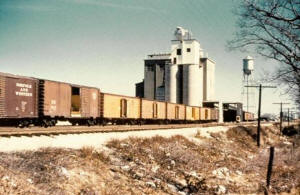
GLF duck-chicken feed plant - View E c.1955
(Emery-SUNY-Stony Brook) |
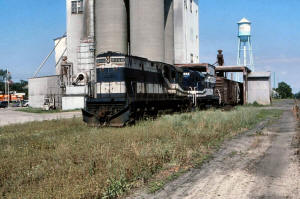
Riverhead - Suffolk Agway - View E 7/1986
Photo/Archive: Jay Bendersky |
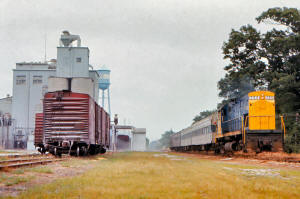
#211 passing the Agway (formerly GLF--Grange League Federation) elevator
in Riverhead on August 17, 1970. Photo/Archive: Richard F. Makse |
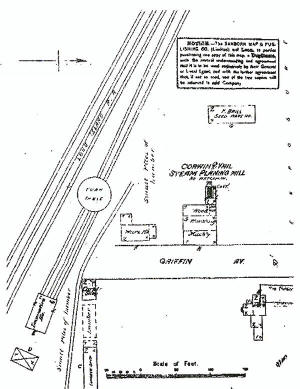
1885 |
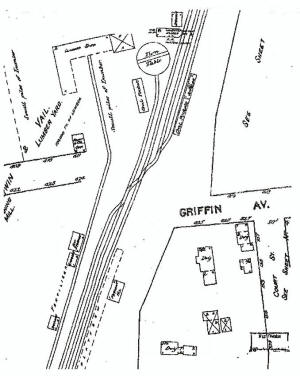
1891 |
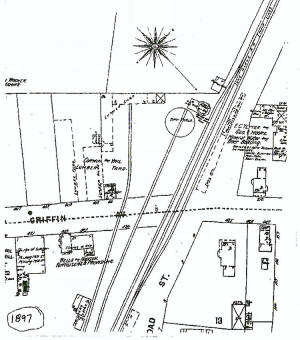
1897 |
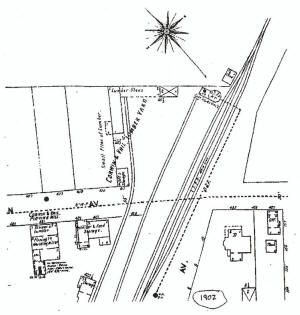
1902 |
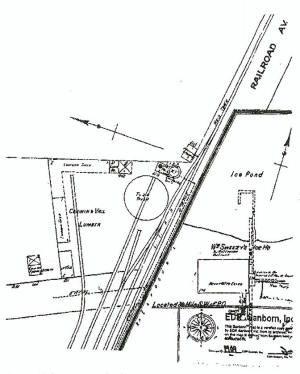
1909 |
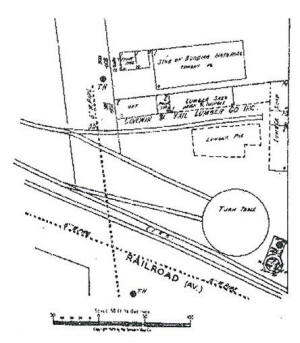
1929 |
|
Riverhead Turntable Sanborn Maps
- Archive: RMLI, Don Fisher |
|
Sanborn map 1885: 1st table
west of Griffin Built <1885 45' - 48' in length (Don Fisher)
Map 1891: 2nd table built <1891 55' in length (Don Fisher)
Map 1897: 2nd table realigned track to the turntable
Map 1902: 2nd table removed <1902 It may have been taken out
after the 1897 map published or up until 1902 map revision update.
Map 1909: Table re-installed <1909 This table
larger then 1891/1897 version. Note 1 And
re-installed in 1902 up until the 1909 map published.. 75' turntable with
the pit wall so very close to the passing siding (Don Fisher) Note 2
Map 1929 The rest of the maps show realignment of tracks to the table. Out
of service 1952.
Note 1: A larger diameter table for bigger engines as K2s (4-6-2) locos
were turned on it. This larger 75’ table, in the same location to replace the 55’
would make it the 3rd different table at Riverhead.
Note 2: The 1909 turntable is larger then the 1891 version. 55’ vs. 75’. Using the
same turntable center pivot the existing 1891 2nd table pit needed to be
dug out another 10’ each way for the newer c.<1909 75’ table.
Sanborn
maps were published in volumes, bound and then updated until the
subsequent volume was produced. Larger cities would be covered by multiple
volumes of maps. Between editions of published volumes, map updates were
sent out as correction slips. Sanborn employees, called "Pasters" or
"Correctors", would visit subscribers' offices to paste the slips on top
of the old maps. Riverhead had two turntable locations, the first
original built west of Griffin and the 55’ to 75’ upgrade east of Griffin
by the School house. Three turntables total. Research: Steven Lynch |
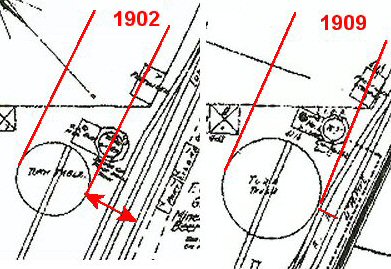
Comparison of the 55' and replacement 75' turntables.
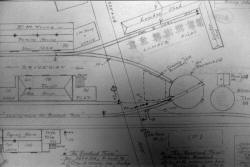
Riverhead turntable - Emery map 10/1957 Archive: SUNY-Stony Brook
Note: Freight/Express House razed 1962 per Emery. |
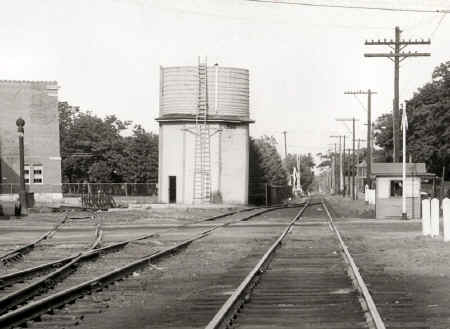
Riverhead water tank and crossing shanty view NE 1940
(Fred Weber - Dave Morrison)
Note: The water spout at the entrance to the turntable for
watering locos in the yard. Info: Dave Keller
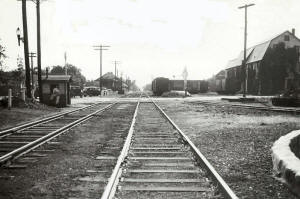
Riverhead Griffin Ave. crossing - View W 1940 (Weber-Morrison) |
.jpg)
Riverhead water tank view NE with the turntable pit and passing siding in
the foreground 1940 (Fred Weber - Dave Morrison)
|
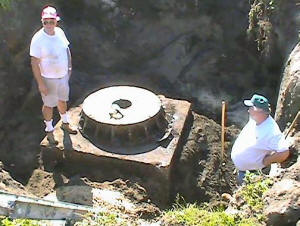
Riverhead turntable pit excavation - Richard Horn (left), Bill Raynor 1998
Photo/Archive: RMLI - Don Fisher |
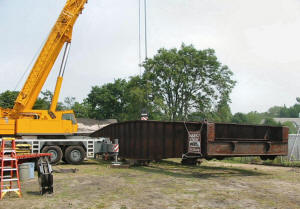
Riverhead turntable project - ex-GTW RR 86' turntable for future
installation
7/08/2002 Photo/Archive: RMLI - Don Fisher |
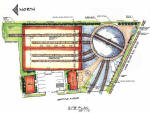
Riverhead turntable property evaluation 2001 Archive: RMLI - Don
Fisher |

Riverhead turntable property evaluation -
View south 2001 Archive: RMLI - Don Fisher |
|
Riverhead Station Area |
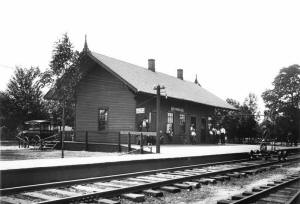
Riverhead Station - View SW c.1905 Archive: Dave Keller
|
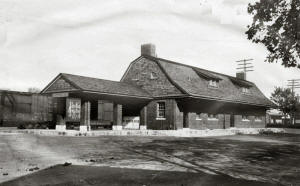
Riverhead Station LIRR
valuation photo rear view NE with the freight house visible at the far right.
10/1917 Archive: Dave Keller |
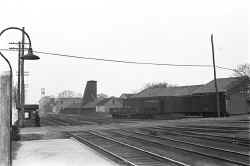
Crossing Shanty - Freight cars spotted
at B. S. Golding's Feed, Osborn
Ave., Riverhead View NW 6/1933 Archive: Dave Keller
|
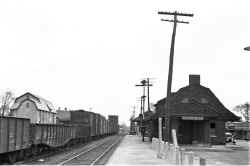
Riverhead Station - RH Block Signals-
Freight on siding
View E 6/1933 Archive: Dave Keller
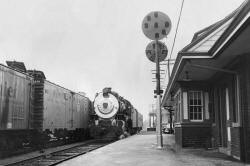
G5s #35 one car Boy Scout Special
Riverhead Station - View E 10/08/1955
(Dave Keller archive) |
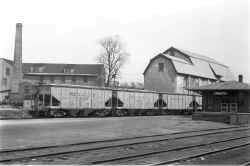
Riverhead Freight House Covered grain
hoppers in yard
View NE 1936 Archive: Dave Keller
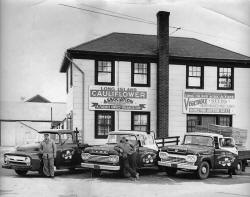
Long Island Cauliflower Association
Marcy Ave., Riverhead 1959+ Archive: TC Fleischman
|
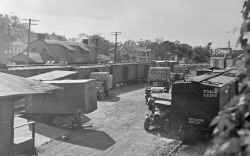
Riverhead Station - View W
11/12/1943 (RMLI-Morrison)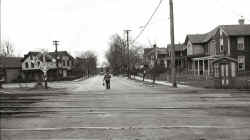
Watchman and crossing
shanty at Osborn Ave., Riverhead
View S c. 1946 (Weber-Keller)
|
|
LONG ISLAND POTATOES |
|
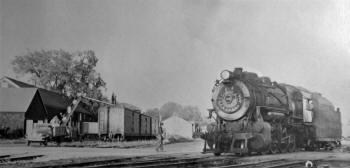
It's 1951 with busy potato
and cauliflower business on the North Fork near Riverhead. The
LIRR dispatched a light engine to Greenport working westbound picking up
the iced loads for NY City markets. Notice the ice truck icing down the
produce, long before mechanical reefers were used.
Riverhead - Reefer being iced c.1951 - Photo: John Krause
|
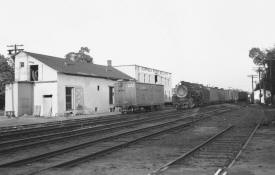
H10s #108 westbound freight passing Suffolk Potato Exchange
Riverhead c.1952 - Photo: John Krause Archive: Dave Keller |
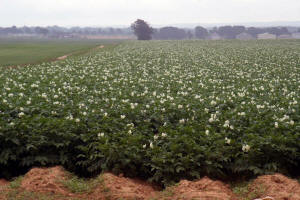
North Fork potato field - Archive: Carolyn Gillespie-Markowitz |
|
A very important food
crop that was grown on Long Island is the potato. The history of the
potato can be traced back to South America around Peru and Chile which the
Indians were growing potatoes for centuries before the Spanish brought the
potato back to Europe. Then the Irish were the first nation to grow the
potato as a filed crop. In 1719 Scotch-Irish settlers in Londonderry New
Hampshire were the first to grow potatoes in America. And later on some
farmers on Long Island started growing the potato.
A new market for
potatoes opened up in Suffolk County when the LIRR built out to Riverhead
and Greenport. Within a few years the market price for potatoes doubled
in price from .18 a bushel to .42 a bushel around 1850. During harvest
time for the potato which is between August and October a farmer would
dig up his potatoes, have them graded, sacked and then brought to a potato
dealer which were located near the LIRR. The potatoes would be weighed and
then dumped into a reefer. The LIRR would then haul the potatoes westbound
to the NYC market. The potato farmer at this time had small fields with
limited production and had to deal with problems such as the potato blight
and getting good seed potatoes which would be planted in March.
In 1908 a few potato
growers formed a stock corporation called the Long island Potato Exchange
in Riverhead. The exchange loaded potatoes, handled fertilizer and other
farm supplies through its warehouse. The company, due to poor management,
went out of business in 1914. By the time America entered World War One
many inventions to help the potato farmer were manufactured as well as
more scientific approaches to agriculture with experimental farms (called
stations) located on Long Island. The Suffolk County Farm Bureau was
organized which helped farmers with the latest information on solving the
problems of production and marketing. Most Long Island potato farmers
bought seed potatoes from Maine but you had to wait out the growing season
to see if it was good crop. The seed potato couldn’t freeze or be kept
hot or it would be a very bad year for the farmer. The State of Maine has
a tight control over the potato and therefore a little chance that a
potato would have fungus. In 1915 a few farmers from Riverhead traveled
north to look over potato fields and selected the best looking fields and
have the seeds shipped to Riverhead in the fall. By 1921 the group formed
a company named the Long Island Produce and Fertilizer Co. They built a
warehouse next to the LIRR tracks in Riverhead just to store potato
seeds. Every March delivering potato seeds to dealers would be good
business for the LIRR.
By the 1920’s there
were over 37 potato houses serving farmers by grading potatoes and packing
them between Calverton and the North and South Fork. Some of these
efficient dealers and packers were Fanning and Housner, Maxim Bobinski,
I.M. Young, Long Island Potato, Grange League Federation, A&P Produce,
Suffolk Produce, Long Island Produce, South Shore Produce. These companies
had many different trackside locations in just about every East End town.
It would be up to a farmer who was watching market prices to decide when
to bring his potatoes to any of the dealers. Some potatoes, depending on
the market price, would be stored throughout the winter and spring to get
the highest price. The potato houses were like warehouses equipped with
fans and ventilating system and humidity and heating equipment. Between
1920 and 1940 the LIRR added new sidings to accommodate many newly built
potato houses in Eastern Long Island such as in 1922 LI Produce in
Riverhead. And in 1924 I.M. Young built a Calverton Potato House and
another one in Riverhead. In 1926 the L.I. Produce completed a fertilizer
warehouse in Mattituck. And in 1946 I.M. Young established themselves in
Bridgehampton with a potato house. These as well as all the other potato
houses were all shipping points for the LIRR. In 1929 the LIRR transported
11,000 carloads of potatoes. And in 1930 10,195 carloads of potatoes were
handled by the rail road. This was the beginning of more truck completion
for the LIRR. And big change that helped farmers everywhere with
production during the dry years was the use of portable overhead
irrigation.
At various times
during the Summer and Fall harvest time the LIRR would station extra
locomotives in Riverhead just to do the switch work at the many sidings in
order to keep the regular road freights from spending too much time in
Riverhead. During the 1930’s Diesel No. 401 or 402 was used. During World
War Two a class H6sb 300 was used. Riverhead was also a turning point for
“Cauliflower Specials” and “Potato Specials” at times. During the 1930’s
it was common to see freight trains with 110 cars of potato reefers being
hauled by the LIRR and mixed freight trains with 70 cars on them.
Between 1943 and 1947
the United States Government purchased practically all of Long Island’s
crops and shipped them all by the LIRR . The freight traffic was so heavy
that the LIRR had to use regular boxcars along with reefers to haul
potatoes and cauliflower westward to Holban yard and points beyond. The
freight business was so good that the LIRR had 36 freight stations
repainted and 30 miles of new rail as well as new ties and ballast
installed in 1943.
One of the problems
that a potato farmer had to be concerned with was being affected by the
golden nematodes. In 1941 a potato field in Nassau County the nematodes
was discovered. It is believed that a US Army World War One surplus tire
that were brought back to the United States from Germany was carrying this
parasite along with dirt in its treads. It is resistant to chemicals and
can remain dormant in the soil for many years. The nematodes will eat away
at the roots of the potato and once found in the soil you will not be able
to grow any more potatoes. This potato filed was purchased by Mr. Levitt
and became Levittown. The golden nematodes is the reason why you are not
allowed to export off Long Island any topsoil, sod, or bring into Maine
any Long Island potatoes. (Interview with Joe Geryela)
LIST-NRHS Michael Bartley |
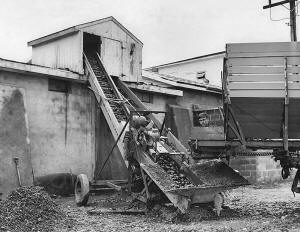
A truck offloads potatoes onto a conveyor and into a storage space at
Philbrick Starch Co. on Raynor Ave. in Riverhead in 1959. Philbrick Starch
Co., a Maine company, open a $200,000 Long Island plant in 1958 which
played a part in a federal subsidization of low-grade potatoes for about
430 Suffolk County farmers. Potatoes were washed, ground, and starch and
protein water were then separated from the pulp which was dehydrated for
cattle feed. The plant was New York State’s first starch factory, but was
shuttered by the county health department when waste materials threatened
to contaminate the water system.
|
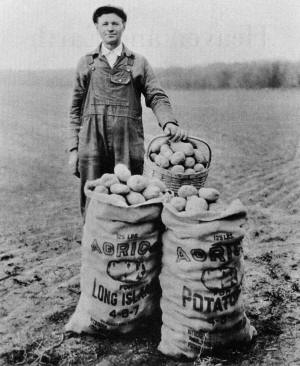
Andrew Dzenkowski, Sr.1935
Photo: Charles Meredith Archive: Southold Historical Society |
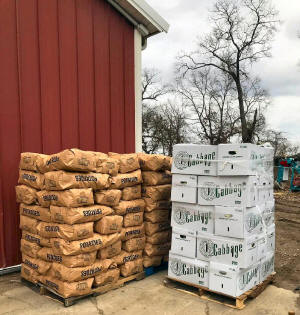
Typical potato and cabbage pallet loads
Archive: Mark Kwiatkoski |
|
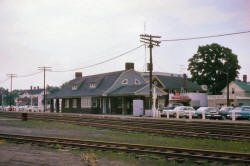
Riverhead Station - 7/01/1964 - Photo/Archive: Brad Phillips |

Riverhead view W at Osborne Ave.
crossing - B. S. Golding's Feed and
Lumber Yard siding 7/01/1964 - Photo/Archive: Brad Phillips |
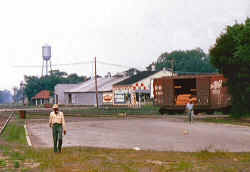
Riverhead view W at Osborne Ave.
crossing - B. S. Golding's Feed and
Lumber Yard siding - 7/01/1964 - Photo: Brad Phillips |
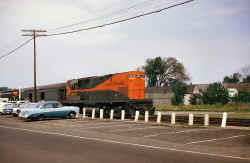
LIRR #210 Train #204 newspaper baggage Riverhead view
W 7/01/1964 - Photo/Archive: Brad Phillips |
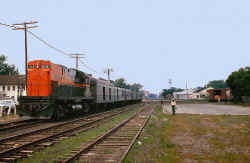
LIRR #210 Train #204 newspaper baggage westbound approaching
Riverhead Station view W 7/01/1964 - Photo/Archive: Brad Phillips |
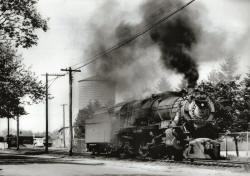
PRR K4s 3751
at Riverhead. View NW
Archive: George H. Lightfoot, III |
The passing of Train #204 - July
1, 1964 was an interesting interlude as it took some time to unload the
newspapers from the baggage car and load
and unload mail from the RPO.
Brad Phillips |
|

Riverhead Station - Eastbound
"Scoot" LIRR #461 Train #202
8/27/1973
Archive: Dave KellerNote: One-car train #202, the Greenport
Scoot, that ran between Ronkonkoma and Greenport. When the daily
train ran between Jamaica and Greenport it was train #204. That
train was cancelled and replaced by this shuttle.
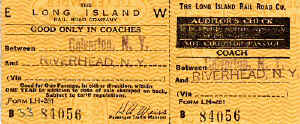
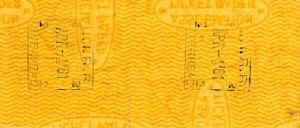
Ticket between Riverhead and Calverton
4/07/1961 Archive: Brad Phillips 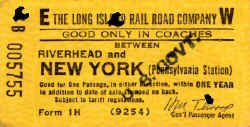
Ticket Form 1H-G Riverhead to Penn Sta.
US Gov't
8/01/1968 -
Archive: Brad Phillips
|
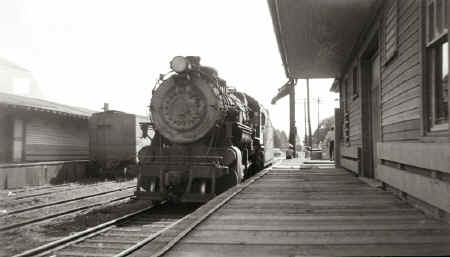
H10s #111 is stopped at the express house and is preparing to take on water
in this c. 1952 view looking east. At the left is the freight house with
boxcar spotted on the house track. (Dave Keller archive)
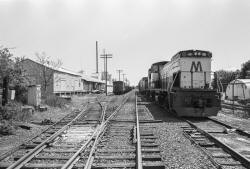
LIRR #151 Riverhead freight - View E of Raynor Ave. c.1985
Photo/Archive: Frank Fiore - Note: Left siding is LI Produce, next 50
car
passing siding, Main
and right is the “Freight Track. (See LIRR maps above)
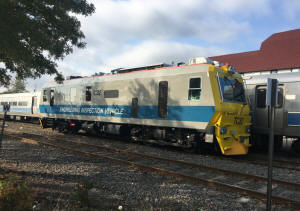
Track Geometry Vehicle - Engineering Inspection Vehicle (EIV) TC82
Riverhead west of station 10/22/2020 - Photo/Archive: Steve Rothaug |
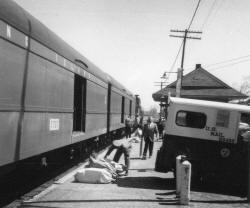
Unloading mail at Riverhead - View E 1964
Photo/Archive: Brad Phillips
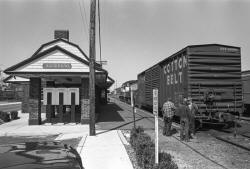
Riverhead RF-62 pair-MP15s c.1990+ Photo/Archive: Frank Fiore
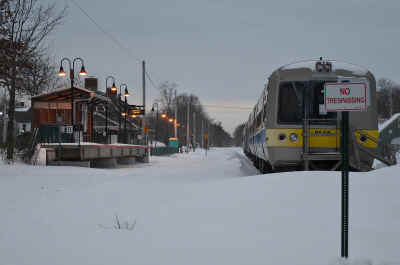
Riverhead Station Hi-level platforms - M1
#9548 View W
1/28/2015 Photo: Edward Hand
|
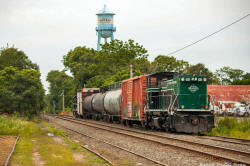
NYA RS70 westbound at LD (Larry Dixon) siding (previously RH) MP73.2
Riverhead 8/03/2021 - Photo/Archive: Daniel Foran
Note: Larry Dixon. former GST General Superintendent of Transportation |
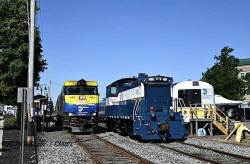
Greenport Scoot Train #6904, #101 in new repaint at Riverhead Railroad
Festival 8/23/2025 - Photo/Archive: William Skeats |
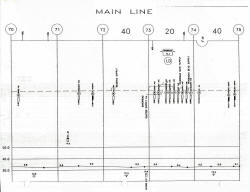
Main Line - Riverhead Track profile map 1994 |
|
|
Riverhead Trackside |
|
 1.-3. LI Ice Company
1.-3. LI Ice Company
4.-5. LI Coal Association
6.-7. LI Produce
8. Suffolk Potato
9. Jackson
Riverhead LIRR Map: Paul Strubeck c. 2008
|
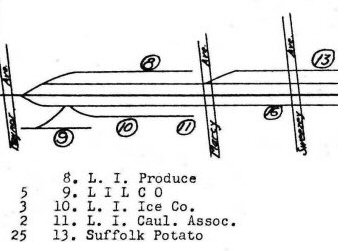
LIRR Siding Map 1966- Raynor Ave to Marcy Ave.
|
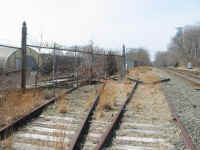
Switch off the siding that enters into Slater's. There is another switch
inside the fence, And this spur once served as a LILCO track. |
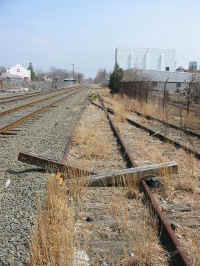
Looking back east you can see the switch leading into
Slater"s and the other switch to get to the buildings. The spur
looking east once served LI Ice Co. and LI Coal Association |
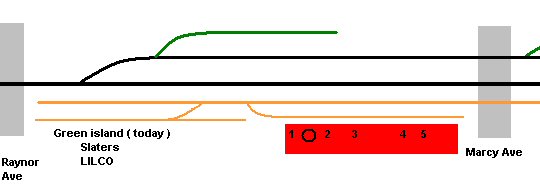
|
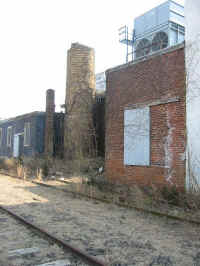
The first unloading door on the spur
(Spot #1 on Map)
|
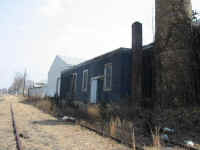
Another unloading door (Spot #2 on Map) |
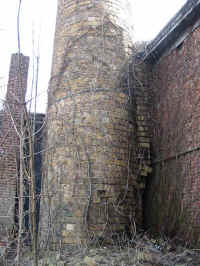
Crumbling smoke stack by the 1st building |
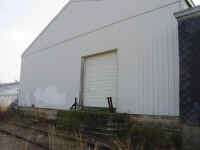
A more modern unloading door
(Spot #3 on Map) |
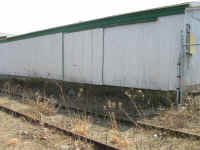
Wooden unloading door (Spot #4 on Map) |
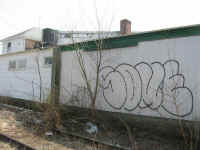
The last unloading door of the spur
(Spot #5 on Map) |
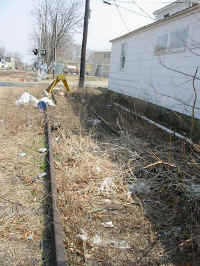
Track Bumper, Just before Marcy Avenue (Spot #5 on Map) |
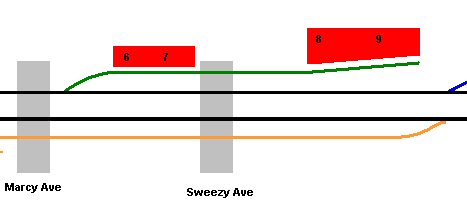 |
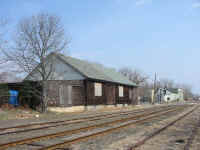
LI Potato Building, No more track
but the ROW is visible. (Spot #6-7 on map) |
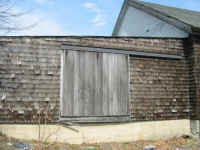
LI Potato 1st Unloading door
(Spot #6 on map)
|
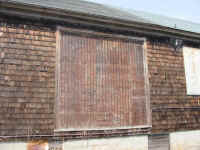
The other unloading door at LI Potato, Now sealed up (Spot #7 on map) |
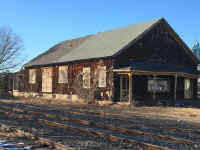
LI Potato Building view N
W 2/20/17 Photo: Steve Rothaug
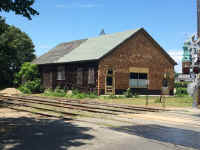
LI Potato Building view N
W 6/21/17 Photo: Steve Rothaug
|
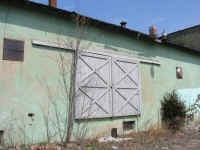
Unloading doors (Spot #9 on map) |
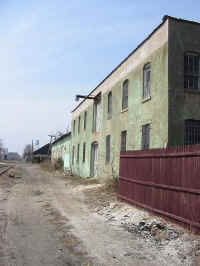
The end of the ROW view W |
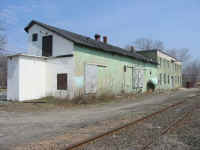
Another building once served off the same ROW, The 1966
map notes this one as just "Jackson",
spots #8 & 9 are visible. View E
|
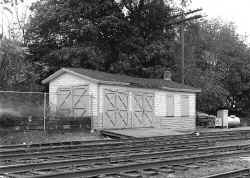
Riverhead
section house west of Osborne Ave. View SW
1971
Photos/Archive: Dave Keller
|
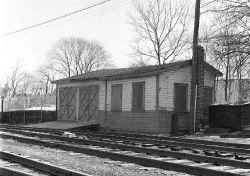
Riverhead
section house west of Osborne Ave. View SE
1970
Photos/Archive: Dave Keller
|
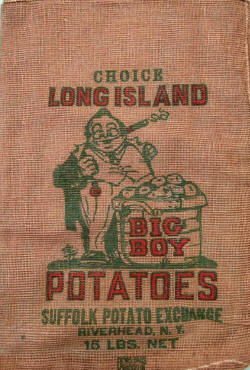
Suffolk Potato Exchange sack Archive: Tommy
Byrne |
|
Photos, descriptions, research and designed maps, not
otherwise noted, are courtesy of Paul Strubeck. |
|

Paraco Gas View SE 1/27/2017
Photo: Steve Rothaug |
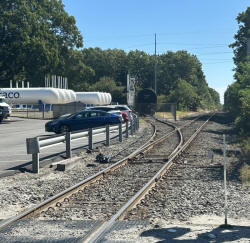
Paraco Gas - View E 8/26/2025
Photo: Steve Rothaug |
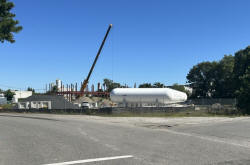
Paraco Gas - 8/26/2025
Photo: Steve Rothaug |
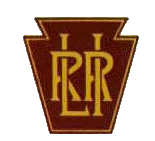 LIRR
- RIVERHEA
LIRR
- RIVERHEA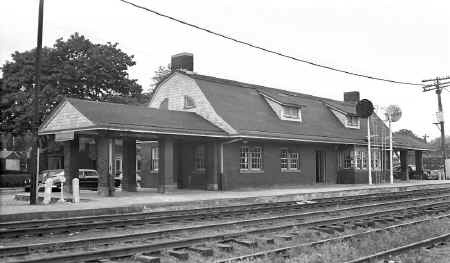
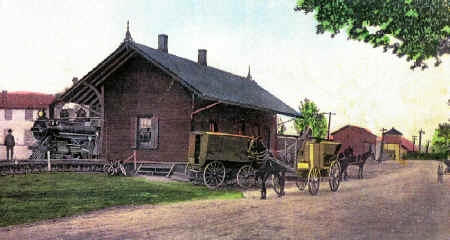
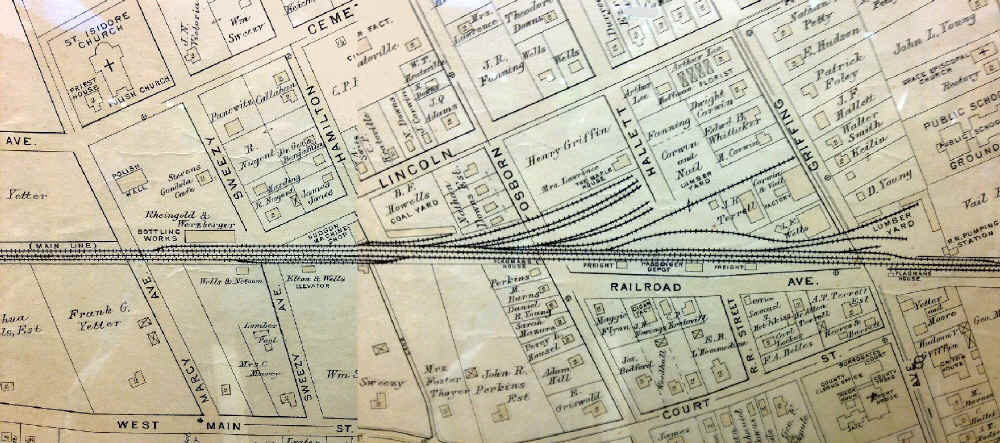
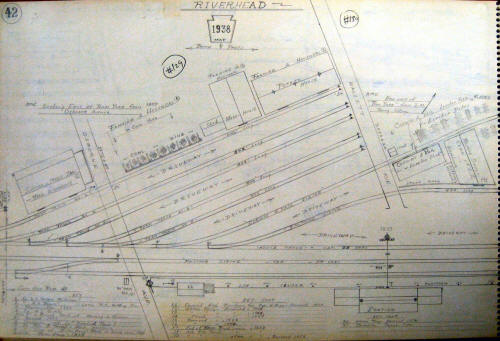
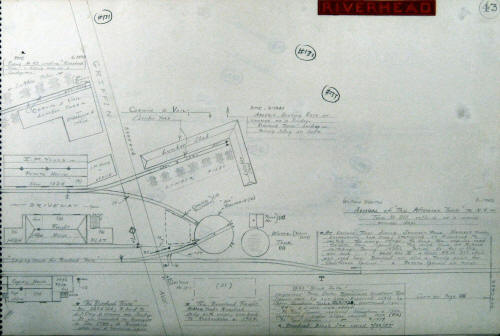
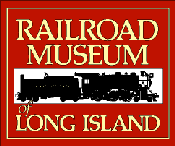 Railroad
Museum LI Trackage, Photos, Info
Railroad
Museum LI Trackage, Photos, Info
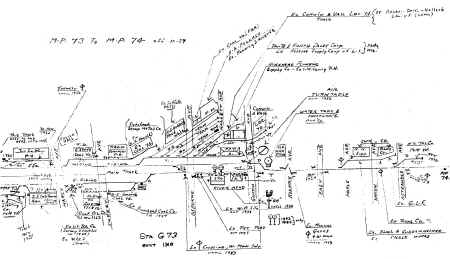
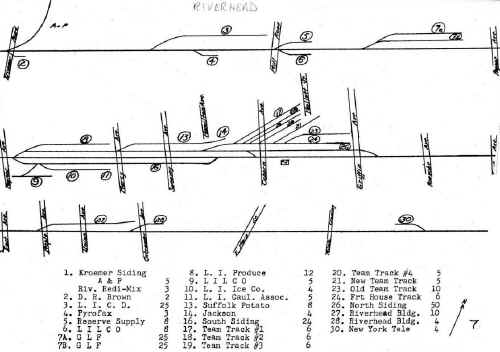
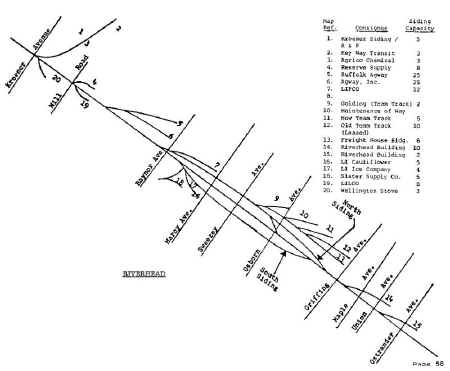
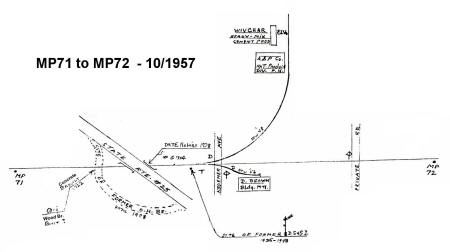















.jpg)
































































